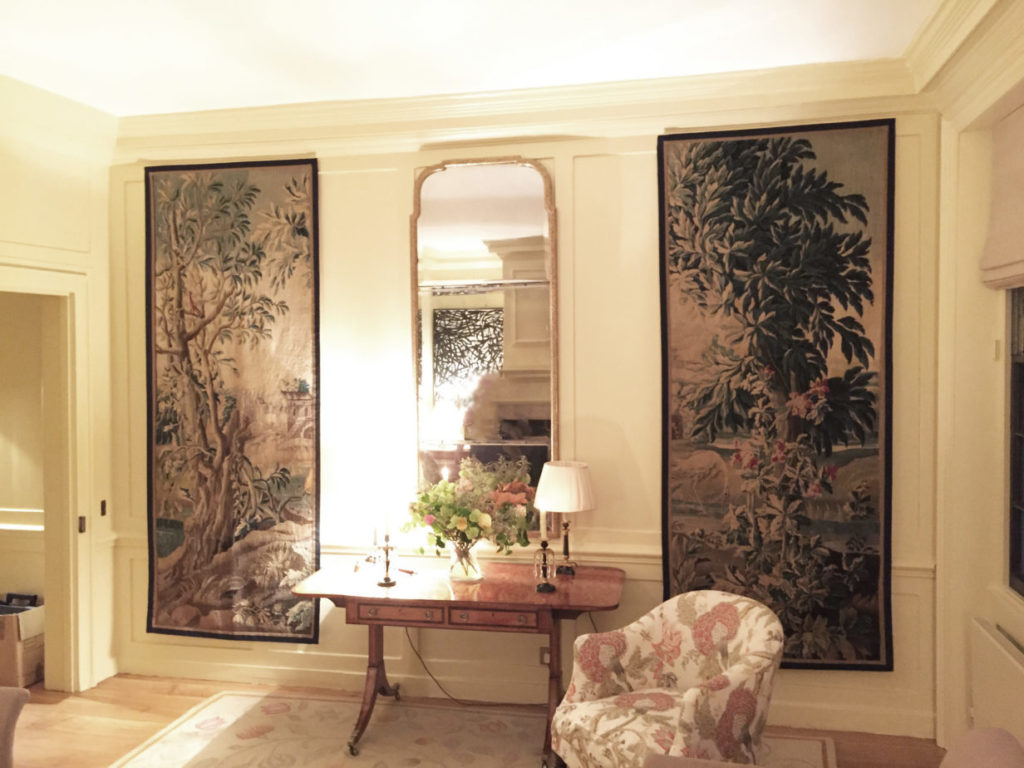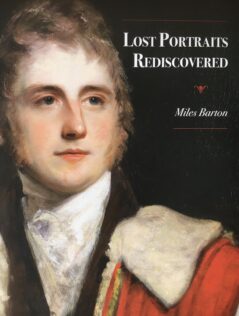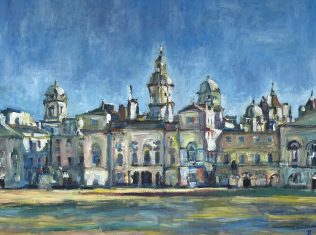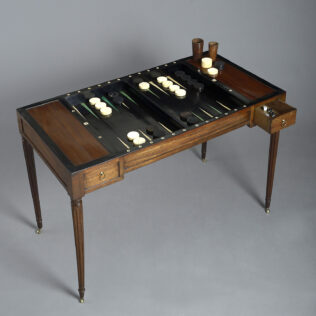Interiors, Special Reports
Inspiration for a Chelsea town house
Chelsea town house interior design
It was a great privilege to work on a wonderful town house project in Chelsea where I was sourcing decorative items and antiques. The end result was an eclectic and thoughtful collection which looked as if it could have been assembled over many decades.
Bringing nature and London into the home
This Queen Anne period house is located close to the river, a stroll away from the site of the former Chelsea Porcelain Factory and The Chelsea Physic Garden and so I was delighted to bring objects and pictures associated with nature, the Thames and some original Chelsea Porcelain into the house. In the Spring, I filmed a visit to the house with architectural historian Oliver Gerrish. In it, we explore the objects room by room and consider the choices made. I hope you will find this interesting and that you can draw some inspiration for your own interior projects. At Timothy Langston Fine Art & Antiques we are delighted to be involved with projects selecting appropriate pieces taking into account heritage, style, colour schemes and personal taste.
Here is the full transcript of the film:
Here we are in Chelsea in London and I’m about to show Oliver Gerrish the inside of a Queen Anne period house we recently helped to furnish.
Oli: Very excited to see it Tim
So let’s have a look inside
Very pretty isn’t it. Very happy colours!
TL: When I first walked into this house – when there was nothing in
it at all – one of the great joys are seeing all the original paneling… the original fireplaces.
Well, the house dates from 1707 And everything from the style of paneling to the dado – it’s all completely original just as the sash windows are and even the marble fire surrounds.
You’ve created a collection, in a way, which could have grown over decades from 1707 onwards.
Absolutely – and nothing’s static. I was very keen, and the client I work with was very keen to show a very living and vibrant, eclectic collection and with lots of references to London.
Lots of references – I mean this picture here: painted in the 18th century shows Greenwich – a wonderful view of the Thames. Isn’t that beautiful. And of course we are very near the Thames being in Chelsea. I was very keen to find some reference to to the Thames so we could bring views of surrounding London into the house. And I always think that building is so related to the Royal Hospital at Chelsea because of course some of it is by Wren of course.
And then you’ve got these lovely oval mirrors which somehow expand the room through their reflection and their shape is echoed in the oval form of the card tables below them. And what’s lovely beacuse I suppose it’s that neoclassical which softens this earlier room in a way.
Its very fine and elegant that work and you’ve got the slightly bigger, blockier paneling of the Queen Anne type.
Absolutely! And I also love to combine circles and oval forms within rectangular spaces: it just somehow, as you say, softens the overall
feel. The grate was actually put in in the Regency period.
Just at the end of the 18th century probably and the club fender we found that as well.
Terribly smart! I think the colour’s so nice: What would you call that the colour of that? It’s almost a celadon green.
Yes – it’s really nice. It’s quite fresh and young.
These ducks are Japanese: Meiji period. And they’re silver gilt bronze. Very, very finely cast and chased.
And what period is the Meiji period?
The beginning of the 20th century
They’re really the finest metalwork to have come out of Japan at the time and they’re courting each other! They’re courting each other yes! [laughter] In conversation!
…And then you’ve got some
lovely maritime pictures going on here.
Yes, now these are hand coloured engravings from the 18th century and they’re the Royal Dockyards: Deptford, Shereness, Woolwich, Chatham, Plymouth and somehow the gold against the blue skies and the ebonised surroundings I mean they they really rather magical.
They glow – yes’ they’re lovely – and the light bounces off this gilt work here.
And if we move on through to this room – this is the dining room…
The paneling’s a bit plainer here: it’s no longer fielded and it hasn’t been recoloured with the secondary colour
So we’re in a cream painted room – but in a colour that’s absolutely right for the period.
Absolutely – and there’s this is lovely buffet niche here which as you filled with treasures!
I’m glad you think so! These are all pieces of Chelsea porcelain which date from in the middle of the 18th century.
The Chelsea porcelain factory, of course, was just a few hundred yards down the road and so the owner of the house was very keen to have some Chelsea porcelain here.
As they might have had at the time!
Almost certainly would have had! So it’s wonderful to bring these pieces back into the house. And as you can see they’re all very floral. Some are almost like botanical studies.
Because you’ve got the Physic Garden down there haven’t you?
Exactly – and with the discoveries of Sir Hans Sloane in the 17th century, it was brilliant to bring that floral theme.
This is a 17th century Verde tapestry fragment. It was made towards the end of the 17th century.
And here you see a parrot seated on this tree. It’s absolutely charming.
You’ve done something slightly different with the chimney breast here: you’ve actually used these the two segments of the upper level with this beautiful glass here. Well I always think it’s nice if you can put an overmantel mirror above a fireplace.
Very lucky to find one that size. I think there’s sort of an inch difference in width!
This of course dates from about 1725/30: Parcel-gilt so it’s painted and carved gesso gilding.
The panel above we found another seafaring picture: this one by Monany and again painted in the early 18th century.
These are Delft tiles and as was very much the tradition use used in this fireplace. These were actually here in the house and I think have been quite
possibly here since the house was built.
So this is their dining room now, because I suppose, at the time, you didn’t necessarily have a dining room. You had parlours. Exactly: so the back parlour.
Back in the hallway you’ve got some beautiful botanical prints here. Well again throughout the house they set on these painted panels and these simple gilded frames these are hand-coloured engravings from the early 18th century showing flora and fauna not only from the
British Isles but from around the world. These were the first great studies of the 18th century as people discovered these extraordinary species through travels.
And what’s lovely if in the wintertime you’ve still got the garden on the walls – in a way.
Well I think it’s very nice to bring the garden in to the house.
And what about this exotic wall light here?
Well these I thought were just great fun. They look like they’ve come off a rather elaborate Venetian coach
or something. There’s something really rather magical. Lovely early glass on the back which almost looks marbleized it’s extraordinary.
It’s sort of perished over time.
And how about this magnificent mirror here?
Well this is glorious: it’s an early 18th century Régence period mirror and it’s wonderful having its original border plates in original mercury glass central plate… fabulous cresting with these exotic birds And again it’s interesting – in these eight early 18th century houses the paneling is not always where you want it to be so you’ve got very skinny one here and you got a wide on here and it shows you do not need to worry about that at all as they wouldn’t have done. No – they wouldn’t absolutely – because paneling was done as insulation and decoration.
But it was quite nice, I thought, to bring a piece of French furniture into the house.
So shall we go upstairs? Look at this lovely barley twists on the stairs.
So this is, without question, my favourite piece in the in the entire collection. This William and Mary period mirror from
about 1690. It has the original beveled plates with these incredible shooting star bevel cuts and the cushion molding in Japaning in wonderful condition floral motifs chinoiseries throughout
I mean it’s just a great piece of furniture and the silver gilt – the silver gilding is stunning. And it’s lovely where you come up the stairs and
straight away that and then pass to a load more beautiful botanical prints!
Yes, again continuing the botanical theme. In bamboo frames.
I found these wonderful gilded bamboo mouldings and I thought they worked really really well. We put them in them.
And again these are from the 18th century.
And then it carries on the sort of chinoiserie theme here
with this lantern here with a pagoda type lantern top. Lovely!
So Tim, you’ve shown us a wonderful 1690s mirror now this is obviously nearly a century later but this is exquisite!
It wonderful – it’s very much in the taste of Robert Adam: pure 1770s neoclassicism with these rams heads the these acanthus scrolls little chains in wonderful condition with the original plate and just another rare survival – really really very pleased to find that
And it heralds the approach to the drawing room I suppose
This is the drawing room.
What a wonderfully proportioned room Isn’t it fantastic! And again on the subject of mirrors I think this is the best convex mirror I’ve ever handled.
Isn’t that marvellous with a seahorse- A hippocampus with stylised dolphins shooting water out their mouths. The best scrolling candle arms and the original plate: that lovely speckled plate as the mercury’s just slowly degrading over time.. It’s gorgeous – and again you’ve got this very deep chimney breast over here and a neoclassical grate.
It’s fantastic! And so Tim from that end of the room to these marvellous tapestries that make the room even higher!
Well we wanted to soften this end of room as well but, as you say, they do get a
tremendous sense of verticality. These are aubusson: they date from the second half of the 18th century
Lovely soft colours – but again with that aubusson red just jumping out there in the parrot
A lovely scene with the mill in the background with these slightly exotic almost Verger type tree sections
They’re almost exactly the same size as these window openings I mean from top to bottom. So again when, at nighttime, or in the winter when it’s miserable outside you’ve got these lovely scenes and again trying to bring the garden indoors.
Yes it’s really clever – it’s beautiful
Here we are in the first-floor bedroom. These are Chinese export for the British market and again following with that theme theme of nature we decided to turn this into an ornithological room. There are pheasants, parrots. What are they painted on? They are painted on paper. And of course a crane here ! And they’re charmingly framed. They’re lovely – you’ve got the gold and it’s very close framed. I quite like that simple style of framing. And this lovely, comfortable chair as well!
We re-covered that.
So, Tim, this is the master bedroom then. And there’s a lovely mirror above there. Yes I was really pleased to find that. That dates for about 1725. So just a few years after the house. Exactly. And it’s got some wonderful light here hasn’t it?
So, gosh, we’re right up in the eves now Tim. So what’s this room?
So this is a little guest bedroom with this wonderful clap boarding Yes it’s great fun and it’s very cozy, very charming. Beautiful lamp! I know, I love this vase it’s a mandarin palette Chinese export porcelain vase. What date? Dates from about 1780 /90 the Qianlong period. Lovely and wonderful scenes of Chinese court life The colours really jump out
Beautiful upholstery all these. Yes we re-upholstered these. Wonderful intricate deep buttoning These are Victorian. Probably the latest
piece of furniture in the house in terms of antiques they date from the 1870s and I just sort of love the form of them. These these slipper chairs
have a lovely very welcoming form and given that we’ve walked up all this way I think we should sit down! Will you ring the bell ? [laughter] I think that will work!
So now we’re in the basement. In the kitchen. Very nice light modern day home. And Queen Anne of course who was reigning when this house was built. We found this mezzotint so it’s nice that she’s got a home here
Look at these amazing wall lights! They’re fun aren’t they: Completely incongruous which is such a fun thing for a kitchen. Well I think they added a certain glitz They’re marvellous! Help you when you’re cooking! Exactly
And I must just show you something [Shows mirror]. Oh look at that. That’s wonderful little mini piece of architecture. It’s fantastic isn’t it with eboniso panels . These Corinthians composition plasters. Absolutely wonderful, Tim. That’s magnificent
You frame yourself within a palace. I think that’s very nice. And the Prince of Wales feathers as well !
So Tim we’re in a really big high room here now – The Garden Room. And did you have fun helping to furnish this? Yes there wasn’t a huge amount to do because the main theme of this really was the book collection. But we did find these 17th century crewel work fragments which I absolutely love. They would have come off a bed hanging. Rich colours of greens, blues, reds… Wonderful survivals: the light hasn’t got to them they’ve actually retained their colour. The colors are very vivid and it’s been echoed a bit with the painting on the the panels
Did you find the chimney-piece. The chimney-piece was here. We did find the chairs and they’ve got a lovely Chinese Export feel about them.
And another thing we found was this pair of lanterns which I was very very
pleased – they look as though they’ve come of the side of an 18th century coach with their little cowels
and everything.
It’s been wonderful to see an early 18th century house sort of with new life breathed into it! Lovely




